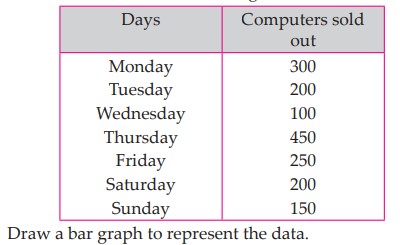Question bank
Chapter-1 Knowing Our Numbers
Q-1 Fill in the blanks:
Q-2 True or False:
Q-3 One word answer:
Q-4
Fill in the blanks :
(i) 1 lakh = ___________ten thousand.
(ii) 1 million = _______________ hundred thousand
(iii) 1 crore = ___________ ten lakh
(iv) 1 million = ___________ lakh.
Q-5
Write the smallest 4-digit number using
(i) only one digit
(ii) different digits
Q-6
Arrange the following numbers in the ascending order:
(i) 2707142, 270714, 2706143, 270613, 2760142
(ii) 6283597, 6284507, 62940507, 63851307
(iii) 63521047, 7354206, 63514759, 7355014, 102345680
(iv) 19998, 1704382, 200175, 1702497, 201200, 1712040
Q-7
Arrange the following numbers in the descending order :
(i) 112345, 121345, 132145, 113234
(ii) 3246, 3426, 46032, 3624
51768, 57168, 56178, 56187
700087, 8014257, 8015032, 10012458, 8014306
Q-8
Write the numeral for each of the following numbers.
(i) Eight thousand seventeen.
(ii) Two lakh sixty thousand four hundred thirty.
(iii) Twenty lakh ten thousand eight.
(iv) Two crore seven lakh sixty three thousand seventy eight.
(v) Twelve crore twelve lakh twelve thousand eighty eight.
(vi) Seven crore three lakh seventy four thousand thirty three.
Q-9
Write the following numbers in words:
(i) 2,34,816
(ii) 32,75,829
(iii) 65,32,75,829
(iv) 3,22,87,008
(v) 3,05,30,604
Q-10
Write the numbers given below in the expanded form :
(i) 15,768
(ii) 20,05,340
(iii) 10,73,487
(iv) 96,04,070
(v) 28,39,42,547
Q-11
Write the correct numbers in short form for each of the following:
(i) 6,00,000 + 80,000 + 2,000 + 60 + 3
(ii) 70,00,000 + 1,00,000 + 30,000 + 4,000 + 5
(iii) 9,00,000, + 9,000 + 800 + 9
(iv) 2,00,00,000 + 5,00,000 + 7,000 + 900 + 5
(v) 30,00,000 + 90,000 + 8,000 + 400 + 80 +8
Q-12
Find the place value and face value of the underlined digit in each of the following numbers:
(i) 742381
(ii) 4723683
(iii) 800671
(iv) 781205.
(v) 9802736
Q-13
Solve:
How many thousands make a lakh?
How many thousands make a crore?
Find the difference between the place value of the two nines in 79520986.
Q-14
Find the greatest and smallest numbers:
(i) 4536, 4892, 4370, 4452
(ii) 15623, 15073, 15189, 15800
(iii) 25286, 25245, 25270, 25210
(iv) 6895, 23787, 24569, 24659
Q-15
Use the given digits without repetition and make the greatest and the smallest 4-digit numbers:
(i) 4, 6, 2, 1
(ii) 7, 4, 0, 3
(iii) 1, 8, 3, 4
(iv) 0, 7, 1, 9
(v) 1, 8, 3, 4
Q-16
Write the greatest and the smallest 5-digit number using all of the following digits. You may repeat the digits:
(i) 7, 5, 2, 8
(ii) 6, 5, 1, 9
(iii) 7, 0, 5, 1
(iv) 8, 6, 7, 2
(v) 2, 0, 7, 8
Q-17
Solve:
Write all 3-digit numbers of different digits formed by using the digit 3, 1, 0, 5 and 7.
Q-18
Insert commas suitably and write the names according to International System of Numeration:
(i) 4321716
(ii) 5,030,469
(iii) 40,050,017
(iv)78,921,092
(v) 7,452,283
(vi) 99,985,102
Q-19
Rewrite the following numbers using the International Place-Value System:
(i) Twenty lakh, five thousand, two hundred nineteen.
(ii) Four crore, twenty six lakh, one thousand twenty four.
Q-20
Write the following numbers in figures:
(i) Twelve lakh, sixty thousand, four hundred thirty.
(ii) Eight crore, two lakh, seventy four thousand, forty four.
Q-21
Numericals:
1. Population of Sundernagar was 2, 35, 471 in the year 2012. In the year 2013 it was found to be increased by 72,958. What was the population of the city in 2013?
2. The cost of a steel almirah is `12985. What is the cost of 946 such almirahs?
3. The town newspaper is published every day. One copy has 12 pages. Everyday 11,980 copies are printed. How many pages are printed everyday?
4. How many millilitres are there in 4.5 litres.
5. The cost of 135 shirts is `42,930. Find the cost of 1 shirt.
6. The sale receipt of a company during a year was Rs.20956480. Next year, it increased by Rs.6709570. What was the total sale receipt of the company during these two years?.
7. By how much is 5643879 smaller than one crore?
8. Medicine is packed in boxes, each weighing 4kg 500g. How many such boxes can be loaded in a van which cannot carry beyond 800 kg?
9. A vessel has 4 litres and 500 ml of curd. In how many glasses each of 25 ml capacity, can it be filled?
Q-22
Round off the following to the nearest tens:
(i) 19 (ii) 42 (iii) 15 (iv) 89 (v) 9005 (vi) 6932
Q-23
Round off the following to the nearest hundred :
(i) 53 (ii) 263 (iii) 387 (iv) 592 (v) 9573 (vi) 7765
Q-24
Round off the following to the nearest thousand:
(i) 6132 (ii) 1780 (iii) 3501 (iv) 5702 (v) 8489 (vi) 599512
Q-25
Solve:
Round off 731 and 164 to the nearest tens. Find the difference of the rounded off numbers. Round off the difference to the nearest hundreds.
A 3-digit number was rounded off to the nearest hundreds and the result was 500. Find the interval of the original number.
Q-26
Estimate each sum to the nearest ten :
(i) 57 + 37 (ii) 95 + 58 (iii) 77 + 63 (iv) 86 + 19
Q-27
Estimate and solve to the nearest hundreds:
(i) 319 + 278 (ii) 687 – 232 (iii) 826 ÷ 199 (iv) 156 × 450
Q-28
Estimate each difference to nearest thousand:
(i) 35863 – 27677 (ii) 47005 – 39488
Q-29
Estimate the following products:
(i) 578 × 161 (ii) 5281 × 3491 (iii) 1291 × 592 (iv) 9250 × 29
Q-30
Find the estimated quotient for each of the following :
(i) 78 ÷ 28 (ii) 75 ÷ 22 (iii) 276 ÷ 25 (iv) 183 ÷ 22 (v) 719 ÷ 21
Q-31
Simplify:
(i) 6 × (10 + 8) (ii) 15 + (434 – 21) (iii) 10 × (20-8) (iv) 68 + (105 + 220) (v) 252 – (305-135)
Q-32
Write the following numbers in Roman numerals:
(i) 36 (ii) 43 (iii) 54 (iv) 61 (v) 73 (vi) 81 (vii) 91 (viii) 95 (ix) 99 (x) 105
Q-33
Write the following numbers in Hindu-Arabic numerals:
(i) IX (ii) XV (iii) XXVII (iv) XXXIV (v) XL (vi) XLIII (vii) LXIX (viii) LXXI (ix) LXXXVI (x) LVII (xi) XLV (xii) XCVII
Multiple Choice Questions
Q-1 The natural number system starts with ________.
(i)
1(ii)
2(iii)
3Q-2 There are _______ numbers.
(i)
two(ii)
infinite(iii)
threeQ-3 The smallest natural number is _________.
(i)
1(ii)
3(iii)
4Q-4 The smallest whole number is __________.
(i)
0(ii)
1(iii)
2Chapter-2 Whole Numbers
Q-1 Fill in the blanks:
Q-2 True or False:
Q-3 One word answer:
Q-4
Solve:
Write next three natural numbers after 27834.
How many whole numbers lies between 41 and 59?
Q-5
Write successor of each of the following:
(i) 909
(ii) 34526
(iii) 76894
Q-6
Write predecessor of each of the following:
(i) 10000
(ii) 7654322
(iii) 500400
Q-7
In each of the following pairs of numbers, state which whole number is on the right of the other whole number on the number line. Also, write them with the appropriate sign > or <
(i) 540, 509
(ii) 416, 614
(iii) 10002, 1002
(iv) 2005, 5002
(v) 9830415, 10023001
Q-8
Write the numbers between:
(i) 30013 and 30020
(ii) 89672 and 89680
Q-9
State whether the following statements are true or false:
(i) Zero is not a whole number.
(ii) All natural numbers are whole numbers.
(iii) 400 is predecessor of 401.
(iv) All whole numbers are natural numbers.
(v) 800 is successor of 799.
(vi) 0 is the only whole number which is not a natural number.
Q-10
Solve:
How many natural numbers are there upto 100 ?
Q-11
Fill in the blanks using properties of whole numbers:
(i) 172 + __________= 425 +__________
(ii) 225 + ___________ = 225 +__________
(iii) __________+217 = 217 + __________
(iv) 4 + (120 + 7) = (4 + 120) + __________
Q-12
Solve:
Add 148, 552 and 750
Q-13
Determine the sum by suitable rearrangements :
(i) 456 + 500 + 44
(ii) 826 + 308 + 674
(iii) 365 + 700 + 635
(iv) 726 + 807 + 947
Q-14
Verify :
(i) 876 + (508 + 348) = (876 + 508) + 348
(ii) (249 + 351) + 646 = (646 + 351) + 259
Q-15
Find the sum by short method.
(i) 567 + 8
(ii) 648 + 99
Q-16
Perform the following subtraction:
(i) 21205 - 10899
(ii) 121456 - 4895
(iii) 1010101-656565
(iv) 16304 - 10540
Q-17
Fill in the blanks:
(i) 2134_____________= 1102
(ii) 8643_____________= 5971
Q-18
Solve:
Find the difference between the smallest 6-digit number and the largest 3-digits number.
Q-19
Solve:
The population of a town was 50000. In one year it increased by 3659 due to new births. However, 6397 persons died or left the town during the year. What was the population at the end of the year. How is the growing population affecting the overall country’s development?
Q-20
Solve:
Mr. Dugal deposited `17536 in his bank account on Monday and `24018 in his bank account on Tuesday. On Wednesday, he withdrew `12600. How much money is left in this accounts?
Q-21
Solve:
The budget for furnishing a flat is `100000. A colour TV is bought for `25,450, a refrigerator for `28900 and a carpet for `12600. How much money is now left in the furnishing budget.
Q-22
Fill in the blanks to make each of the following statements true:
(i) 798 × 0 = _________________
(ii) 7680 × 1 = __________________
(iii) 374 × 123 = 123 ×______________
(iv) 38 × (91 × 37) = _________× (38 × 37)
(v) 16 × 45 = 16 × 50 – 16 ×_______
Q-23
Find the products by suitable rearrangement:
(i) 2 × 1768 x 50
(ii) 285 × 5 × 60
(iii) 278 × 40 × 25
(iv) 4 × 475 x 5
(v) 225 × 60 × 50 × 8
Q-24
Find the value of the following:
(i) 297 × 17 + 297 × 3
(ii) 661 × 93 + 7 × 661
(iii) 678 × 999 + 678
(iv) 631 × 10 × 467– 367 × 6310
(v) 569 × 17 + 569 × 13 + 569 × 70
Q-25
Find the product using suitable properties:
(i) 5778 × 102
(ii) 854 × 103
(iii) 1005 × 168
Q-26
Solve:
Find the product of the largest 4-digit number and the smallest 3-digit number.
Q-27
Solve:
A taxidriver planned a trip to his home town filled his car tank with 40 litres of petrol on Monday. The next day, he filled the tank with 50 litres of petrol. If the petrol cost Rs.44 per litre, how much did he spend in all on petrol? Can you recall your last trip to your ancestral village?
Q-28
Solve:
The number of students in each class of a school is 50. The fee paid by each student is Rs.406 per month. If there are 20 classes in the school, what is the total fee collections in a month?
Q-29
Solve:
A dealer purchased 138 mobile phones. If the cost of each set is Rs.14250, find the cost of all the sets together.
Q-30
Solve:
A vendor supplies 32 litres of milk to a hotel in the morning and 68 litres of milk in the evening. If the milk cost Rs.15 per litre, how much money is due to the vender per day.
Q-31
Solve:
The teacher purchased 42 Mathematics books and 39 English books for his class. If the cost of a Mathematics books is Rs.52 and the cost of an English book is Rs.44. Find the total amount paid by the teacher to the shopkeeper.
Q-32
Solve:
If the product of two whole numbers is zero, can we say that one or both of them will be zero ? Justify through example.
Q-33
Study the following pattern :
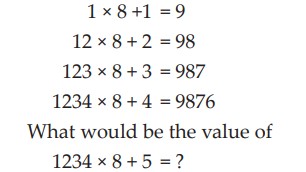
Q-34
Complete the series :
(a) 340, 342, 344, 346, ____, ____, _____,
(b) 510, 515, 520, 525,____, ____, _____,
(c) 493, 490, 487, 484,____, ____, _____,
(d) 10, 30, 50, 70, ____, ____, _____,
Multiple Choice Questions
Q-1 Mathematicians call the counting number as __________ number.
(i)
natural(ii)
whole(iii)
none of theseQ-2 Every natural number has _________.
(i)
successor(ii)
Whole number(iii)
predecessorQ-3 _______ is the first and the smallest whole number.
(i)
0(ii)
1(iii)
2Q-4 The predecessor of a given whole number is 1 __________ than the given number.
(i)
more(ii)
greater(iii)
lessChapter-3 Playing with Numbers
Q-1 Fill in the blanks:
Q-2 True or False:
Q-3 One word answer:
Q-4
Find the value of :
(i) 150 – 30 ÷ 5
(ii) 25 + 40 ÷ 4
(iii) 7 × 3 – 4 + 60 ÷ 10
(iv) 30 + 14 ÷ 2
(v) 48 ÷ (5 + 7)
(vi) 8 × 5 – 15 ÷ 5 + 7
Q-5
Simplify :
(i) 20 – (10 + 2 – 3)
(ii) 7 – (6 + 4 – 8)
(iii) 100 – {60 – 2 of (25 – 15)}
(iv) 70 + 2 × 5 + 3 of 10 – 60 ÷ 6
(v) 128 – [56 – {3 × 5 + ( 19 – 2 of 3)}]
(vi) [20 – 2 (5 – 4)] × {3 – (5 – 3)}
Q-6
. Write all the factors of the following numbers :
(i) 24
(ii) 60
(iii) 36
(iv) 21
(v) 27
(vi) 125
(vii) 144
(viii) 64
Q-7
Write the first five multiples of
(i) 6
(ii) 12
(iii) 8
(iv) 16
(v) 5
(vi) 7
(vii) 19
(viii) 25
Q-8
Match the items in column I with the items in column II.
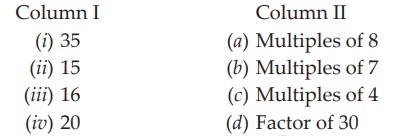
Q-9
Solve:
Find all the multiples of 8 between 60 and 100.
Q-10
Solve:
Write down separately the prime and composite numbers less than 20.
Q-11
Check the following for being prime or composite :
23, 26, 31, 51, 109.
Q-12
Solve:
Write down the numbers between 10 and 30 which have exactly 2 factors.
Q-13
Express each of the following numbers as the sum of two odd primes.
(i) 36
(ii) 98
Q-14
Express each of the following odd numbers as the sum of twin primes.
(i) 84
(ii) 120
Q-15
Express each of the following numbers as the sum of these odd prime numbers.
(i) 49
(ii) 35
Q-16
Solve:
Write seven consecutive composite numbers less than 100 so that there is no prime number between them.
Q-17
State True or False :
(i) All even numbers are composite.
(ii) Odd numbers cannot be composite.
(iii) The product of prime numbers cannot be prime.
(iv) 1 is the smallest prime number.
(v) A number and its successor are always co-prime.
Q-18
In each of the following, fill in the blanks with the smallest digit to make it divisible by 3 :
(i) – 6724
(ii) 75 – 3
(iii) 135 – 8
(iv) 206 – 38
Q-19
In each of the following, fill in the blanks with the smallest digit to make it divisible by 9 :
(i) 487 – 6
(ii) 41 – 67
(iii) 60 – 12
(iv) 7 – 0514
Q-20
Solve:
By which digit should the box be replaced in 79 62 so that the resulting number is divisible by 11?
Q-21
Express the following as a product of Prime factor :
(i) 84
(ii) 216
(iii) 150
(iv) 725
(v) 230
(vi) 13310
(vii) 2145
(viii) 160
Q-22
Solve:
Write the smallest 5-digit number and express it in the form of its prime factors.
Q-23
Solve:
Find the smallest number having four different prime factors.
Q-24
Solve:
Write the name of the factors that are not included in the prime factorisation of a composite number.
Q-25
Find the common factors of :
(i) 12 and 15
(ii) 10 and 28
(iii) 15 and 25
(iv) 56 and 120
(v) 8, 12, and 15.
Q-26
Find first three common multiples of :
(i) 2 and 4
(ii) 5 and 7
Q-27
Find the HCF of the following numbers :
(i) 30, 42
(ii) 84, 98
(iii) 170, 238
(iv) 34, 102
(v) 32, 800, 480
(vi) 312, 260, 156
(vii) 72, 108, 180
(viii) 144, 252, 630
(ix) 106, 159, 71
(x) 70, 105, 75
Q-28
Find the HCF of the numbers in each of the following , using the division method:
(i) 58, 70
(ii) 1045, 1520
(iii) 658, 940, 1128
(iv) 858, 1562, 1870
(v) 540, 696
(vi) 136, 170, 255
Q-29
Solve:
Find the greatest number which divides 1628, 1736 and 268 leaving remainder 8, 11, and 13 respectively.
Q-30
Solve:
Find the greatest number which divides 615 and 963 leaving the remainder 6 in each case.
Q-31
Solve:
A rectangular room is 7 m 83 cm long and 5 m 13 cm broad. What is the dimension of the largest square tile that can be fixed on the floor completely?
Q-32
Solve:
Find the greatest number which divides 418, 1354, 2146 and 2338 exactly leaving reminder 10 in each case.
Q-33
Solve:
The length, breadth and height of a room are 825 cm, 675 cm and 450 cm respectively. Find the longest tape which can measure the three dimensions of the room exactly
Q-34
Solve:
Three pieces of timber, 42 m, 49 m and 63 m long, have to be divided into planks of the same length. What is the greatest possible length of each plank.
Q-35
Solve:
Determine the longest tape which can be used to measure exactly the lengths 7 m, 3 m 85 cm and 12 m 95 cm
Q-36
Solve:
A room is 5 m 60 cm long80 and 2 m 40 cm broad. What is the dimension of the longest square tile that can be fixed on the floor so that the tiles need not be cut to fit the floor.
Q-37
Determine L.C.M of the given numbers in each of the following :
(i) 36, 60
(ii) 72, 90
(iii) 15, 30, 90
(iv) 28, 15, 42
(v) 62, 94
(vi) 45, 90, 150
Q-38
Determine the LCM of the following numbers by common division method :
(i) 88, 64
(ii) 24, 27, 30, 90
(iii) 20, 25, 30
(iv) 12, 15, 20, 27
(v) 22, 54, 108, 135, 198
(vi) 32, 56, 46
Q-39
Solve:
Find the least number, which when divided by 15, 45, and 60 leaves remainder 6 in each case.
Q-40
Solve:
Find the least number, which when divided by 20, 30, 40 leaves a remainder of 7 in each case
Q-41
Solve:
Determine the two numbers nearest to 10,000 which are exactly divisible by 2, 3, 4, 5, 6 and 7.
Q-42
Solve:
Find a number between 800 and 900 which is divisible by 22, 33 and 66.
Three bells ring at intervals of 9 minutes, 12 minutes and 24 minutes respectively. At what time will they ring together if they start ringing simultaneously at 1:00 PM?
Q-43
Solve:
Four children step off together while going to school. Their steps measure 28 cm, 32 cm, 36 cm and 48 cm respectively. At what distance from the starting point will they step off together again?
Q-44
Solve:
The HCF of two numbers is 16 and their product is 3072. Find their LCM.
Q-45
Solve:
The HCF of two numbers is 23 and their LCM is 1449. If one of the numbers is 161. Find the other.
Q-46
Solve:
The HCF of two numbers is 5 and their LCM is 595. If one of the numbers is 85, find the other.
Q-47
Solve:
The HCF of two numbers is 12 and their product is 4320. What is their LCM ? If one of the numbers is 60, what is the other number?
Q-48
Solve:
The product of two numbers is 1280 and their LCM is 160. Find their HCF.
Multiple Choice Questions
Q-1 ( ) are known as _________ bracket, also called first bracket.
(i)
common(ii)
uncommon(iii)
perfectQ-2 { } are known as curly bracket, also called ________ bracket.
(i)
first(ii)
second(iii)
none of theseQ-3 [ ] are know as square bracket, also called _________ bracket.
(i)
first(ii)
second(iii)
thirdQ-4 — is known as ________.
(i)
line bracket(ii)
bar(iii)
both of these
Q-5 Using divisibility test, determine which of the following numbers are divisible by 2.
(i)
(i) 5280
(ii)
(ii) 6427
(iii)
(iii) 7328
(iv)
(iv) 5193
Q-6 Using divisibility test, determine which of the following numbers are divisible by 4 and by 8 :
(i)
(i) 572
(ii)
(ii) 726352
(iii)
(iii) 5500
(iv)
(iv) 1700
(v)
(v) 6000
(vi)
(vi) 12159
(vii)
(vii) 14560
(viii)
(viii) 21084
Q-7 Using divisibility test, determine which of the following numbers are divisible by 6 :
(i)
(i) 297144
(ii)
(ii) 1258
(iii)
(iii) 4335
(iv)
(iv) 901352
(v)
(v) 2832
(vi)
(vi) 4452
(vii)
(vii) 12583
(viii)
(viii) 639210
Q-8 Using divisibility test, determine which of the following numbers are divisible by 11:
(i)
(i) 5445
(ii)
(ii) 7138965
(iii)
(iii) 10824
(iv)
(iv) 70169308
(v)
(v) 10000001
(vi)
(vi) 901135
Chapter-4 Integers
Q-1 Fill in the blanks:
Q-2 True or False:
Q-3 One word answer:
Q-4
Give the opposites of :
(i) Increase in population
(ii) 300 BC
Q-5
Use the number line to write points corresponding to each of the following :

(i) Opposite of 7
(ii) 3 units less than 4
(iii) 6 units less than 1
(iv) Value opposite of A
Q-6
Insert > or < sign in the box :

Q-7
Arrange the following numbers in ascending order :
(i) – 4, – 125, – 21, – 60, – 48
(ii) – 98, – 75, – 14, – 32, – 47
Q-8
Arrange the following numbers in descending order :
(i) – 2, – 15, – 53, – 26, – 85
(ii) – 27, – 76, – 115, – 36, – 160
Q-9
Represent the following numbers on a number line :

Q-10
Locate the larger integer in each of the following pairs of integers :
(i) 1, 6
(ii) – 1, – 6
(iii) 0, 4
(iv) 5, 7
Q-11
Using the number line and write >, = or < in the boxes in each case :

Q-12
Solve:
Write four negative integers greater than – 20.
Q-13
Solve:
Write four negative integers less than – 10.
Q-14
Write the following in ascending order :
(i) |– 18|, |– 64|, – |13|, – |– 46|, – |– 72|
(ii) |48|, |– 47|, – |– 54|, – | – 30 |, |– 72|
Q-15
Write the following in descending order :
(i) |– 32|, – | – 68 |, |–75|, |80|, –|52|
(ii) |48|, – 47, – |– 52|, – ( – 28 ), |– 50|
Q-16
Find the value of
(i) |– 49|
(ii) |– 3546|
(iii) |9 – 8|
(iv) 25 – |– 12| + |– 10|
Q-17
Write absolute value of each :
(i) 6
(ii) – 7
(iii) 0
(iv) – 193
Q-18
Solve:
How many integres are between –3 and 5. Write them in order.
Q-19
Add the following integers :
(a) – 410 and 172
(b) 120 and – 10
(c) – 88 and – 43
(d) 200 and – 75
Q-20
Subtract the following integers :
(a) + 11 from + 5
(b) – 6 from – 14
(c) + 114 from + 1024
(d) + 68 from – 32
Q-21
Multiply.
(a) (– 9) × 4 (b) 140 × (– 5)
(b) 140 × (– 5)
(c) (– 13) × (– 13)
(d) (– 6) × (– 4) × 5 × (– 10)
(e) (– 7) × (– 5) × 2 (– 15) × 0
(f) (– 2) × (– 5) × 4 × (– 2) × (– 1)
(g) (– 1) × (– 3) × (– 25)
(h) 12 × 12 × (– 5)
Q-22
Divide
(a) (– 108) ÷ 12
(b) 0 ÷ (– 13)
(c) 144 ÷ (– 16)
(d) (– 15625) ÷ 25
(e) (– 322) ÷ (– 14)
(f) (– 192) ÷ 8
(g) 101 ÷ (– 101)
(h) (– 1000 ÷ 100)
Q-23
Simplify.
(a) (– 4) + 12 + (– 20)
(b) 41 + (– 11) + (– 17)
(c) (– 200) + 110 + (– 20) + 210 + (– 5)
(d) (– 7) + 5 + (– 8) + (– 11)
Q-24
Solve:
Subtract 211 from the difference of –20 and –57.
Q-25
Solve:
Add – 41 to the difference of –220 and – 176.
Q-26
Solve:
The sum of two integers is – 20. If one of the integers is 120, find the other.
Q-27
Solve:
The sum of two integers is 88. If one of the integers is – 28, find the other.
Q-28
Solve:
Suraj travelled 32 km north and Ashish travelled 74 km south from the same point. Find the distance between the destinations of the two.
Q-29
Solve:
Determine the integer that when divided by – 1 gives – 56.
Q-30
Solve:
What will be the sign of the product if we multiply six negative integers and two positive integers ?
Q-31
Solve:
Critical Thinking : What is the difference between the successor and the predecessor of an integer ? Can we generalise it as a rule ?
Multiple Choice Questions
Q-1 A gain of 300 is written as _______.
(i)
+300(ii)
-300(iii)
none of theseQ-2 A loss of 300 is written as ______.
(i)
+300(ii)
-300(iii)
none of theseQ-3 Increase in temperature of 6° C is represented as ______.
(i)
+6 degree celsius(ii)
-6 degree celsius(iii)
none of theseQ-4 Decrease in temperature of 6° C is represented as _______.
(i)
+6 degree celsius(ii)
-6 degree celsius(iii)
none of theseChapter-5 Fractions
Q-1 Fill in the blanks:
Q-2 True or False:
Q-3 One word answer:
Q-4
Find the equivalent fractions of 5/8 with
(i) Numerator 25
(ii) Numerator 20
(iii) Numerator 45
(iv) Denominator 16
(v) Denominator 64
Q-5
Write a fraction that represents the shaded part of each figure given below :

Q-6
Shade 1/3 portion of the figure.

Q-7
Find numerator and denominator of each fraction :
(i) 4/10
(ii) 6/7
(iii) 8/5
(iv) 3/13
Q-8
Solve:
What fraction of a day is 8 hours?
Q-9
Solve:
What fraction of an hour is 40 minutes?
Q-10
Write the fraction whose:
(i) N = 4 D = 6
(ii) D = 3 N = 7
(iii) N = 8 D = 5
(iv) D = 7 N = 9
Q-11
Solve:
Write the natural numbers from 102 to 113. What fraction of them are prime numbers?
Q-12
Represent each of the following fraction on the number line :

Q-13
Insert >, = or < in the box :

Q-14
Solve:
Show 1/10, 0.10, 5/10 and 10/0 on a number line.
Q-15
Solve:
Write five fractions each with denominator 5 and less than 1.
Q-16
Fill in the blanks :


Q-17
Express the following as mixed fractions :
(i) 25/7
(ii) 38/14
(iii) 19/3
(iv) 28/5
(v) 19/6
(vi) 35/9
Q-18
Express the following as improper fractions :
(i) 9*2/5
(ii) 5*3/4
(iii) 7*2/5
(iv) 10*3/5
(v) 9*3/7
(vi) 8*4/9
Q-19
Write five fractions equivalent to each of the following:

Q-20
Which of the following are the pairs of equivalent fractions?

Q-21
Fill in the blanks :

Q-22
Solve:
Ramesh had 20 pencils, Sheela had 50 pencils and Jamaal had 80 pencils. After 4 months, Ramesh used up 10 pencils, Sheela used up 25 pencils and Jamaal used up 40 pencils. What fraction did each used up? Check if each has used up an equal fraction of her/his pencils?
Q-23
Match the equivalent fractions and write two more in you note book for each :

Q-24
Compare the fractions and put an appropriate sign :

Q-25
In each of the group identify like fractions :

Q-26
Compare the fractions given below :

Q-27
Arrange the following in ascending order :

Q-28
Arrange the following in descending order:

Q-29
Solve:
Rashmi read 25 pages of a book containing 100 pages. Pari read 2/5 of the same book. Who read less?
Q-30
Solve:
Luvnish exercised for 3/6 of an hour while Gagan exercised for 3/4 of an hour. Who exercised for a longer time?
Q-31
Solve:
Rachita walks 3/7 part of a certain distance and Mansi walks 5/8 part of the same distance in the same time. Who walks faster?
Q-32
Solve for the like fractions :

Q-33
Solve for the unlike fractions :















Q-34
Numericals:
Renu did 1/2 of the work yesterday and one-third of the work today. How much work will she have to do tomorrow to complete the work?
(ii) In a vegetable garden 1/6 of the area is covered with lettuce and 5/12 with tomato plants. What fraction of the area is planted with these?
(iii) Of 5/7 and 9/14 , which is greater and by how much ?
(iv) What should be added to 8*7/15 to get 11*1/5 ?
(v) A piece of wire 3*3/4 metres long, broke into two pieces, one piece is 3/8 metres long. How much long is the other piece?
(vi) Kaviya bought three pieces of clothes measuring 1*5/6 m, 2*5/8 m and 3*7/12 m. What was the total length of the cloth purchased?
(vii) The weight of two boxes together is 5*3/4 kg. If one box weigh 2*5/6 kg, find the weight of the other.
(viii) Naina was given 1*1/2 piece of cake and Najma was given 1*1/3 pieces of cake. Find the total amount of cake given to both of them.
Multiple Choice Questions
Q-1 Fraction indicates _______ parts of a whole things.
(i)
equal(ii)
unequal(iii)
none of theseQ-2 1/2 means that one whole thing is divided into _________ equal parts.
(i)
two(ii)
three(iii)
4Q-3 A _______ is a quantity which expresses a part of the whole.
(i)
fraction(ii)
decimal(iii)
integerQ-4 In 4/5, 4 is the ______.
(i)
numerator(ii)
denominator(iii)
fraction
Q-5 Which of the following are proper fractions?
(i)
(i) 5/8
(ii)
(ii) 1/2
(iii)
(iii) 7/4
(iv)
(iv) 6/19
(v)
(v) 5/11
Q-6 Which of the following are improper fractions?
(i)
(i) 5/6
(ii)
(ii) 9/4
(iii)
(iii) 23/31
(iv)
(iv) 13/10
(v)
(v) 19/12
Q-7 Which of the following fractions are not in the simplest form? Reduce them to their simplest form.
(i)
(i) 15/14
(ii)
(ii) 25/56
(iii)
(iii) 20/84
(iv)
(iv) 63/34
Chapter-6 Decimals
Q-1 Fill in the blanks:
Q-2 True or False:
Q-3 One word answer:
Q-4
Write the following decimals in the place value table :
(i) 19.4 (ii) 12.6 (iii) 0.8 (iv) 105.8
Q-5
Write each of the following in figures or decimals :
(i) Nineteen point eight
(ii) Point one seven three
(iii) Three point seven six one
(iv) Twenty-one point nine five two
(v) Two hundred point seven
(vi) One hundred point two one
Q-6
Write in the expanded form :
(i) 67.83
(ii) 475.3
(iii) 176.8
(iv) 701.4
(v) 0.294
Q-7
Write each of the following in words:
(i) 0.8
(ii) 3.56
(iii) 10.58
(iv) 701.5
(v) 0.851
(vi) 27.004
(vii)100.57
(viii) 105.29
Q-8
Write the following as decimals:
(i) 3/10
(ii) 5/10
(iii) 1/5
(iv) 2/5
(v) 4/100
(vi) 7/1000
(vii) 8/100
(viii) 9/10
(ix) 5/1000
Q-9
Write each of the following in the decimal form :
(i) 30 + 6 + 5/10 + 7/100
(ii) 400 + 30 + 7 + 2/10 + 3/100 + 9/1000
(iii) 2000 + 400 + 30 + 5/10 + 6/100 + 8/1000
(iv) 600 + 5 + 7/100 + 9/1000
Q-10
Show the following numbers on the number line :
(i) 0.2
(ii) 1.9
(iii) 1.1
(iv) 2.5
Q-11
Arrange the following decimals in ascending order :
(i) 6.54, 6.45, 6.4, 6.5, 6.05
(ii) 0.6, 6.6, 6.06, 66.6, 0.06
Q-12
Arrange the following decimals in descending order :
(i) 3.3, 3.03, 30.3, 30.03, 3.003
(ii) 7.3, 8.73, 73.03, 7.33, 8.073
Q-13
Place value of digits are given. Write them in decimals form :
(i) 3 tens 4 ones 1 Tenth 7 hundredths
(ii) 7 hundred 3 tens 8 ones one Tenth
Q-14
Write >, = or < in the boxes

Q-15
Which is greater?
(i) 1 or 0.99
(ii) 1.09 or 1.093
(iii) 0.3 or 0.4
(iv) 0.07 or 0.02
(v) 0.5 or 0.05
(vi) 3 or 0.8
(vii)1.5 or 1.50
(viii) 5.64 or 5.603
Q-16
Convert the following decimals into fractions:
(i) 0.04
(ii) 3.7
(iii) 4.56
(iv) 0.002
(v) 66.89
Q-17
Convert the following fractions into decimal fractions :
(i) 6/10
(ii) 14/100
(iii) 758/10
(iv) 1279/10
(v) 67/1000
Q-18
Arrange the following in ascending order:
(i) 0.8, 2.9, 2.7 and 0.68
(ii) 4.38, 0.56, 2.526 and 0.59
Q-19
Arrange the following in descending order:
(i) 0.9, 2.85, 0.409 and 2.56
(ii) 1.23, 5.78, 0.29 and 0.348
Q-20
Convert the following fractions to decimal by converting the denominators to 10, 100, 1000 etc.
(i) 2/5
(ii) 9/2
(iii) 11/4
(iv) 16/25
(v) 131/250
Q-21
Express in rupees using decimals
(i) Rs.26 and Rs.75 paise
(ii) Rs.35 and 8 paise
(iii) Rs.6 and 9 paise
Q-22
Express as metre using decimals
(i) 15 cm
(ii) 6 cm
(iii) 195 cm
(iv) 1328 cm
Q-23
Express as cm using decimals :
(i) 9 mm
(ii) 67 mm
(iii) 164 mm
(iv) 9 cm 8 mm
(v) 93 mm
Q-24
Express as km using decimals :
(i) 8 m
(ii) 39 m
(iii) 87 m
(iv) 7867 m
(v) 70 km 5m.
Q-25
Write each of the following in expanded form:

Multiple Choice Questions
Q-1 The fractions in which the denominators are 10, 100, 1000, etc; are known as _________ fractions.
(i)
integer(ii)
decimal(iii)
properQ-2 2/10 is a _______ fraction.
(i)
integer(ii)
decimal(iii)
none of theseQ-3 1/10 fractions names the number _______.
(i)
one-ninth(ii)
one-tenth(iii)
none of theseChapter-7 Algebra
Q-1 Fill in the blanks:
Q-2 True or False:
Q-3 One word answer:
Q-4
Find a rule which connects the two quantities in each of the following tables:


Q-5
Find the rule which gives the number of matchsticks required to make the following matchsticks patterns. Use a variable to write the rule :
(i) A pattern of letter T
(ii) A pattern of letter U
(iii) A pattern of letter S
(iv) A pattern of letter V
Q-6
Frame algebraic expressions for the following :
(i) Half of a number added to 7
(ii) A number increased by 12
(iii) Four times a number divided by another number
(iv) Thrice x added to y squared
(v) x minus twice y.
Twice the sum of a number and another number which is three more than the first number.
Q-7
Solve:
A bird flies 1 kilometre in one minute. Can you express the distance covered by the bird in terms of its flying time in minutes?
Mother has made laddus. She gives some laddus to guests and family members; still 5 laddus remain. If the number of laddus mother gave away is l, how many laddus did she make?
The teacher distributes 5 pencils per student. Can you tell how many pencils are needed, given that the number of students is 7.
Q-8
Write the algebraic expressions in the form of statements.
(i) 3y + 3
(ii) 42x – 5y
Q-9
A number y is always 13 less than a number x
(i) Write down the rule which connects x and y.
(ii) Find y when x is 16.
Q-10
Separate constant and variables from the following:

Q-11
Write each of the following in exponential form:
(i) a × a × a ........... 16 times
(ii) z × z × z × z × y × y × y
(iii) 3 × 5 × x × x × x × y × y
(iv) p × p × p × p × 2 × q × q × r × s
Q-12
Find the value of the following expressions, if a = 3 and b = 4.

Q-13
Find the value of the following expressions if b = 6, c = 4 and x = 2.
(i) 4 (b + x)
(ii) 3b – 2 (c + x)
(iii) x (2b + c – 3)
Q-14
Identify the binomials from the following expressions:
Q-15
Identify the like terms of the following:

Q-16
Write the coefficient of x in the following terms:
Q-17
Write the coefficient of x in the following terms:

Q-18
Solve the following equations :

Q-19
Solve the following equations :
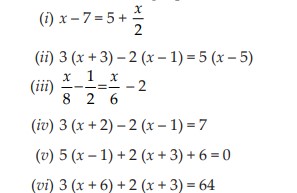
Q-20
Complete the table and by inspection of table find the solution to the equation m + 10 = 16.

Q-21
Complete the table and find the solution of the equation using the table.

Q-22
Using a variable write the following statements in equation form :
(i) A number added to 18 results 36.
(ii) Twice a number add to the number result 33.
(iii) Four times a number is 28.
(iv) One fifth of a number is 7
(v) Four times a number subtracted from 50 leaves a remainder 2.
Q-23
Numericals:
1. . If 9 is added to a certain number, the result is 36. Find the number.
2. If a number is tripled and the result is increased by 5, we get 50. Find the number.
3. The length of a rectangular park is thrice its breadth. If the perimeter of the park is 168 metres. Find its dimensions.
4. Luvnish is twice as old as his brother Vicky. If the difference of their ages be 11 years, find their present ages.
5. If 11 is subtracted from 4 times a number, the result is 89. Find the number.
6. The sum of two consecutive even number is 74. Find the number.
7. After 16 years lucky will three times as old as he is now. Find his present age.
8. The sum of three consecutive natural numbers is 114. Find the numbers.
9. The length of a rectangular park is thrice its breadth. If the perimeter of the park is 168 metres, find its dimensions.
10. After 32 years, Vicky will be 5 times as old as he was 8 years ago. How old is Vicky today?
Multiple Choice Questions
Q-1 ________ is a generalized form of Arithmetic.
(i)
Algebra(ii)
Integer(iii)
none of theseQ-2 Number patterns can be used to help you discover ways to represent certain types of numbers using ________.
(i)
variables(ii)
constants(iii)
none of theseQ-3 2 is an ______ number.
(i)
even(ii)
odd(iii)
none of these
Q-4 Which out of the following are expressions with number only?
(i)
(i) y + 3
(ii)
(ii) (7 × 20) – 8z
(iii)
(iii) 5 (21 – 7) + 7 × 2
(iv)
(iv) 5
(v)
(v) 3x
(vi)
(vi) 5 – 5n
(vii)
(vii) (7 × 20) – (5 × 10) – 45 + P
Q-5 Identify the binomials from the following expressions:
(i)
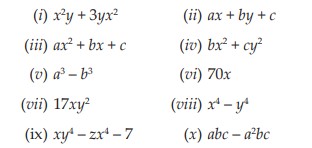
Chapter-8 Ratio and Proportion
Q-1 Fill in the blanks:
Q-2 True or False:
Q-3 One word answer:
Q-4
Find the ratio of :
(i) 45 to 60
(ii) 72 to 84
(iii) 36 minute to 1 hour
(iv) 15 kg : 30g
(v) 24 m to 96 cm
(vi) 40 paise to Rs. 2
Q-5
Find the ratio of the following in the simplest form :
(i) 100 to 25
(ii) 60 to 80
(iii) 330 : 550
(iv) 0.2 : 0.8
(v) 1 cm : 1 mm
(vi) 1 hour : 20 minutes
(vii) 8 l to 560 ml
Q-6
Numericals:
1. Three-fourth of the workers in a factory are men while the remaining one-fourth are women. Find the ratio of the male workers to the female workers in the factory.
2. Reshma and Sonali have Rs.128 and Rs.192 respectively. Express the amounts they have as a ratio in the simplest form.
3. A earns 3 times as much as B. If B earns Rs.1500 then (i) How much does A earn ? (ii) What is the ratio between the earnings of B and A ?
4. Find the ratio of the price of coffee to that of tea when coffee costs Rs.24 per 100g and tea costs Rs.80 per kilogram.
5. The number of boys and girls in a school are 1168 and 1095 respectively. Express the ratio of the number of boys to that of the girls in the simplest form.
6. Length and breadth of a rectangular field are 20 m and 15 m respectively. Find the ratio of the length to the breadth of the field.
7. The ratio of copper and zinc in an alloy is 5 : 3. If the weight of copper in the alloy is 30.5 grams. Find the weight of zinc in the alloy.
Q-7
Determine and state which rows have a different ratio of boys to balls.
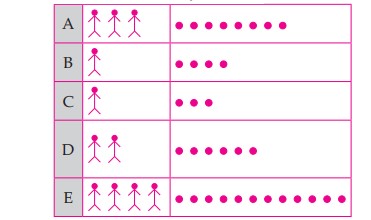
Q-8
Which ratio is greater?
(i) 7 : 8 or 2 : 3
(ii) 9 : 16 or 4 : 11
(iii) 8 : 15 or 7 : 13
(iv) 7 : 21 or 2: 5
Q-9
Which ratio is smaller?
(i) 10 : 7 or 22 : 15
(ii) 11 : 14 or 2 : 5
(iii) 1 : 7 or 5 : 22
(iv) 3 : 11 or 2 : 15
Q-10
Solve:
1. Divide Rs.120 between Saroj and Sonal in the ratio 3 : 5.
2. Cost of a dozen pens is Rs.180 and cost of 8 ball pens is Rs.56. Find the ratio of the cost of a pen to the cost of a ball pen.
3. Divide 20 pens between Sheela and Sangeeta in the ratio of 2 : 3.
4. A and B purchased an article for Rs.500. If A paid Rs.300 and the rest was paid by B, what is the ratio of amounts paid by A and B?
5. Divide Rs.1200 among A, B and C in the ratio 2 : 3 : 5.
There are 28 boys and 36 girls in a party. Find the ratio of (i) Boys to girls (ii) girls to total number of children
Q-11
Determine if the following are in proportion:

Q-12
Find x in each of the following proportion :
(i) x : 3 : : 57 : 19
(ii) 66 : 22 : : x : 8
(iii) 18 : x = 54 : 18
(iv) 5 : 35 : : x : 14
(v) 80 : 100 : : 84 : x
(vi) 10 : 15 : : 12 : x
Q-13
Write true (T) or false (F) against the following statements:
(i) 21 : 35 = 24 : 40
(ii) 66 : 99 = 38 : 57
(iii) 15 : 20 = 55 : 44
(iv) 15l : 10kg = 25l : 20kg
Q-14
Solve:
1. Find the 3rd term of a proportion whose 1st, 2nd and 4th terms are respectively 15, 45 and 54.
2. Find the 4th term of a proportion whose 1st, 2nd and 3rd terms are respectively 18, 24 and 6.
3. Find a term in between 4 and 36 so that 4th term and 36 make a proportion.
4. Find the cost of 15 books if cost of 5 for `205.
5. Do the ratios 15 cm to 2m and 10 sec to 3 minutes form a proportion?
6. If the interest on a sum of Rs.1750 for a year is Rs.140, what is the rate percent of interest per annum?
7. We need 20kg of rice to serve 100 people. How much rice would be needed for 40 people?
8. Cost of 4 dozen of bananas is Rs.60. How many bananas can be purchased for Rs.12.50?
9. The cost of 6 exercise books is Rs.90. What is the cost of 25 such books?
10. Anish made 42 runs in 6 overs and Anup made 63 runs in 7 over. Who made more runs per over?
11. 22*1/2 m of silk costs `214.20. What is the cost of 6*3/4 m ?
12. 20 bars of chocolate cost `320. Find the cost of 35 such chocolate bars.
13. If the cost of 6 cans of juice is Rs.210 then what will be the cost of 4 cans of Juice?
14. A motorbike travels 220 km in 5 litres of petrol. How much distance will it cover in 1.5 litres of petrol?
15. If the cost of a dozen soaps is Rs.153.60, what will be the cost of 15 such soaps?
16. A worker is paid Rs.178.50 for 5 days. What should be paid to him for 28 days?
17. The weight of 44 folding chairs is 22 kg. How many chairs can be loaded on a truck having a capacity of carrying 4000 kg load?
Multiple Choice Questions
Q-1 We denote ________ using the symbol (:).
(i)
ratio(ii)
proportion(iii)
integerQ-2 As a ratio, we read 1/3 as “1 to 3”, and not 1/3 as ______.
(i)
one-third(ii)
one-fourth(iii)
one-fifthQ-3 The quantities a and b are called terms of the ratio, a is called the first term or _________.
(i)
antecedent(ii)
consequent(iii)
none of theseQ-4 The quantities a and b are called terms of the ratio, b is called the second term or _________.
(i)
antecedent(ii)
consequent(iii)
fractionChapter-9 Basic Geometrical Ideas
Q-1 Fill in the blanks:
Q-2 True or False:
Q-3 One word answer:
Q-4
Name the line given in all possible (twelve) ways, choosing only two letters at a time from the four given.

Q-5
Answer the following questions :
(i) What is the edge of brick like?
(ii) How many line can be drawn through a point?
(iii) What is the tip of a cone like?
(iv) What are the points not located on the same line called?
Q-6
How many lines are drawn in the figure given below.

Q-7
Name this line in three different ways.

Q-8
In the adjoining figure, name:

(i) Four line segments
(ii) Four rays
(iii) Two non-intersecting line segments.
Q-9
Classify the following curves as:

(i) open or
(ii) closed
Q-10
Draw rough diagrams to illustrate the following :
(i) Open curve
(ii) Closed curve
Q-11
Solve:
1. Draw any closed curve and shade its interior
2. Draw any closed curve and shade its exterior.
Q-12
Draw a polygon having :
(i) 3 sides
(ii) 4 sides
(iii) 5 sides
(iv) 8 sides
Q-13
Solve:
1. Name the angles in the given figure.
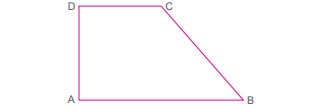
2. Name three examples of angle from your daily life.
Q-14
In the given figure, name the points

(i) In the interior of ∠XOZ.
(ii) In the exterior of ∠YOZ.
(iii) On ∠YOZ.
(iv) In the interior of ∠XOY.
Q-15
Write another name for the following angles in the given figure:
(i) ∠1
(ii) ∠2
(iii) ∠3
(iv) ∠4
(v) ∠5
(vi) ∠6

Q-16
Solve:
1. In the given diagram AC is a line. Are BA, BC and BD rays? There are three angles in the figure. One is ∠ABC. What are the others?

2. Name the following triangles :

3. In the given figure, name the three angles, sides, base and vertical angle of the triangle ABC.
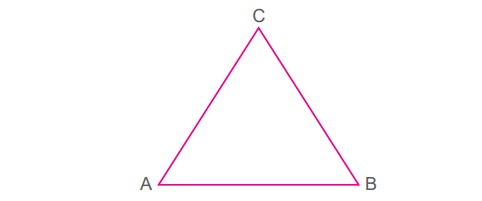
4. How many triangles are formed in the figure?
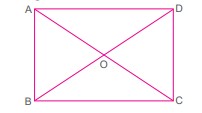
5. Draw a rough sketch of a triangle ABC. Mark a point P in its interior and a point Q in its exterior. Is the point A in its exterior or in its interior?
6. Draw a rough sketch of a Quadrilateral PQRS. Shade its exterior.
7. Take a point O inside a given Quadrilateral ABCD. Join the point O to sides the vertices A, B, C and D. Into what figures will the quadrilateral be divided? Name the figures.
Q-17
Draw a rough sketch of a quadrilateral KMLN state :
(i) Two pairs of opposite sides
(ii) Two pairs of opposite angles.
(iii) Two pairs of adjacent sides.
(iv) Two pairs of adjacent angles.
Q-18
Fill in the blanks :
(i) The radius of a circle is ___________ of its diameter.
(ii) Diameter of a circle is the ___________ chord.
(iii) End points of all chords of a circle lie at ___________ points.
(iv) An ___________ is any part of circle.
(v) The distance between any two points on a circle is called an ___________.
(vi) All the radii of a circle are ___________.
Q-19
Draw any circle and mark :

Q-20
Look at the given circle with centre O. State the term for each of the following:

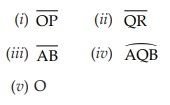
Q-21
Write True (T) or False (F) :
(i) The radius is the longest chord of the circle.
(ii) Diameter = 1/2 × radius
(iii) Concentric circle have the same centre
(iv) Line joining two distinct points on a circle is called a secant.
(v) There are infinitely many diameters of a circle.
Q-22
Look at these figures. In each figure, state the points that lie on the circle, in the interior of the circle or in the exterior of the circle.
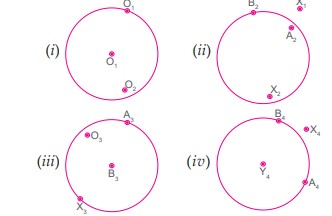
Multiple Choice Questions
Q-1 __________ has a long and rich history.
(i)
Geometry(ii)
Numbers(iii)
none of theseQ-2 Geo means ________.
(i)
Earth(ii)
sky(iii)
none of theseQ-3 Metron means _______.
(i)
metre(ii)
measurement(iii)
both of theseChapter-10 Understanding Elementary Shapes
Q-1 Fill in the blanks:
Q-2 True or False:
Q-3 One word answer:
Q-4
Measure the following line segments with a ruler :
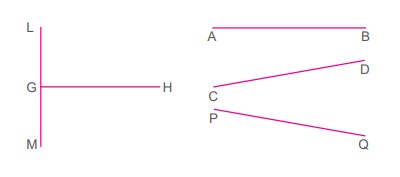

Q-5
Without actual measurement, state true or false.

(i) AC + BD = AD + BC
(ii) AB + CD =AD — BC
Q-6
Which direction will the hands of a clock stop if it
(i) starts at 12 and makes 1/2 of a revolution, clockwise?
(ii) starts at 2 and makes 1/2 of a revolution, clockwise?
(iii) starts at 5 and makes 1/4 of a revolution, clockwise?
(iv) starts at 5 and makes 3/4 of a revolution, clockwise?
Q-7
Name the vertex and the arms of each angle given in the figure :
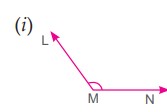
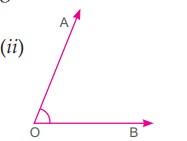
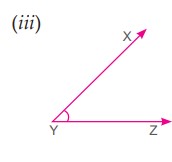

Q-8
What fraction of clockwise revolution does the hour hand of a clock turn through when it goes from?
(i) 3 to 9
(ii) 5 to 8
(iii) 8 to 11
(iv) 12 to 9
(v) 2 to 11
(vi) 6 to 3
Q-9
Which direction will you face if you start facing:
(i) East and make 1/2 of a revolution clockwise?
(ii) East and make 1*1/2 of a revolution clockwise?
(iii) west and make 3/4 of a revolution anti-clockwise?
(iv) South and make one full revolution ?
Q-10
Numericals:
1. If you stand facing North and turn in either direction through a complete revolution in which direction are you facing?
2. If you stand facing West and turn clockwise to face South, what part of a revolution have you turned through?
3. If B is the mid-point of AC and C is the mid-point of BD , where A, B, C, D lie on a straight line, say, why AB = CD?
4. Draw five triangles and measure their sides, check in each case, if the sum of length of any two sides is greater than the third side.
5. Give three examples of angles from your daily life.
6. Can a triangle have two right angles?
7. Can a triangle have two obtuse angles?
8. Can an obtuse angled triangle be an equilateral triangle?
9. Draw a rhombus ABCD with AB = 6 cm and AC = 5 cm.
10. What is a trapezium? When do you call a trapezium an isosceles trapezium?
11. Name the quadrilateral which has just one pair of parallel sides.
12. The ratio of two sides of a parallelogram is 3:4. If its perimeter is 56 cm, find the lengths of the sides of the parallelogram.
13. The adjacent sides DA and AB of a parallelogram ABCD are 3 cm each. State the measurements of all the sides. What is another name for this figure?
14. A regular polygon has equal angles. Is this true?
15. Draw a rough sketch of a regular hexagon. Connecting any three of its vertices, draw a triangle. Identify the type of the triangle you have drawn.
16. A diagonal is a line segment that joins any two vertices of the polygon and is not a side of the polygon. Draw a rough sketch of a pentagon and draw its diagonals.
Q-11
Classify the following angles as zero, acute, right, obtuse, straight, reflex and complete angles :
(i) 42°
(ii) 92°
(iii) 179°
(iv) 205°
(v) 0°
(vi) 79°
(vii) 90°
(viii) 1°
(ix) 359°
(x) 360°
(xi) 100°
(xii) 180°
Q-12
What is the magnitude of the angles formed between the two arms of a clock at the following times? (Do not take any reflex angles) :
(i) 3:00 p.m.
(ii) 12 noon
(iii) 8:00 a.m.
(iv) 9:00 a.m.
(v) 10:00 a.m.
(vi) 4:00 p.m.
Q-13
How many angles are formed in each of the figures given below? Name them.
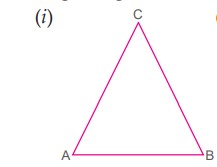
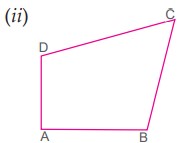

Q-14
What is the angle measure between the hands of the following clocks?


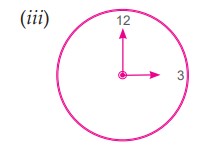
Q-15
Name each of the following triangles in two different ways: (You may judge the nature of the angles by observation).

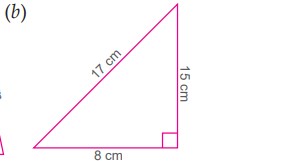
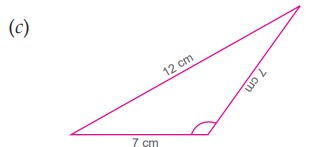



Q-16
Classify the triangles the measure of whose sides are given below as scalene, isosceles or equilateral :
(i) 6 cm , 8 cm, 10 cm
(ii) 5.8 cm, 7 cm, 5.8 cm
(iii) 6.9 cm, 8.3 cm, 9.2 cm
(iv) 4.5 cm, 4.5 cm, 4.5 cm
Q-17
Match the following :
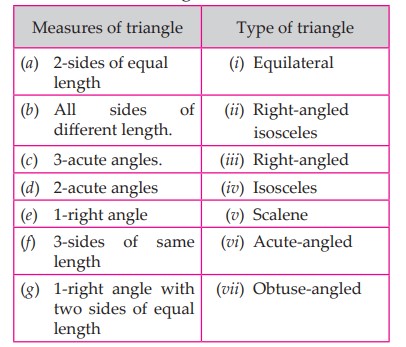
Q-18
Classify the following triangles as acuteangled, right-angled or obtuse-angled triangles according to the magnitude of their angles:
(i) 40°, 60°, 80°
(ii) 15°, 75°, 90°
(iii) 10°, 20°, 150°
(iv) 60°, 60°, 60°
(v) 70°, 70°, 40°
(vi) 20°, 20°, 140°
Q-19
Give reasons for the following:
(a) A square can be thought of as a special rectangle.
(b) A rectangle can be thought of as a special parallelogram.
(c) A square can be thought of as a special rhombus.
(d) Squares, rectangles, parallelograms are all quadrilaterals.
(e) Square is also a parallelogram.
Q-20
Name each polygon :
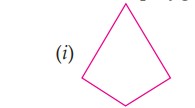
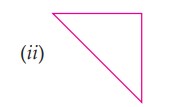


Q-21
Fill in the blanks :
(i) A five-sided polygon is called as ________________.
(ii) The number of sides of a hexagon is ________________.
(iii) If the sum of all the angles of a polygon is 360° it is called a ________________.
(iv) The diagonal of a rhombus bisect each other at ________________.
(v) A cube is a special cuboid whose all sides are _____________.
(vi) A cuboid has _____________ vertices, _________ faces and _________ edges.
(vii) The ____________ faces of cuboid are identical.
(viii) A square pyramid has _____________ lateral triangular faces and __________ edges.
Q-22
Complete the following table :
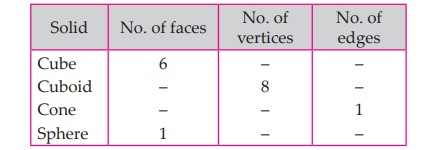
Q-23
Give examples of four objects which are in the shape of :
(i) a cone
(ii) a cuboid
(iii) a cylinder
Q-24
Write the name of each shape.

Q-25
The nets of some solids are given below. Trace each net and cut out the traced copy. Fold the cutout along the edges to form a solid. Name the solid :

Multiple Choice Questions
Q-1 All the shapes we see around us are formed using _________.
(i)
lines(ii)
curves(iii)
both of theseQ-2 A line segment is a fixed portion of a __________.
(i)
point(ii)
line(iii)
none of theseQ-3 Length of a line segment is measured in terms of a standard _________ segment.
(i)
line(ii)
unit(iii)
none of theseChapter-11 Mensuration (Perimeter and Area)
Q-1 Fill in the blanks:
Q-2 True or False:
Q-3 One word answer:
Q-4
Find the perimeter of each of following shapes:
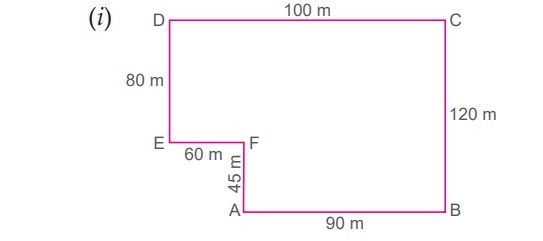
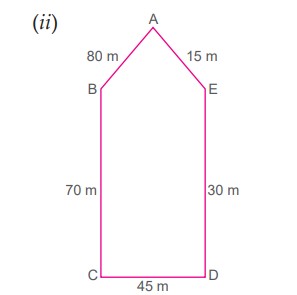
Q-5
Numericals:
1. Measure and write the length of the four sides of a page of your notebook. The sum of the lengths of the four sides = = AB + BC + CD + DA =____ cm +____ cm +____ cm +____ cm + =______ cm
2. Ritu went to a park 130 m long and 90 m wide. She took one complete round of it. What distance did she cover?
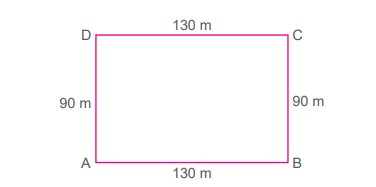
3. Find the perimeter of a rectangle whose length and breadth are 150 cm and 1 m respectively.
4. Find the perimeter of a rectangular field which is 36 m long and 24 m wide.
5. Find the cost of fencing a rectangular field 24 m long and 18 m wide at `6.25 per metre.
6. An athlete takes 10 rounds of a rectangular park 50 m long and 25 m wide. Find the total distance covered by him.
7. Find the cost of fencing a square park of side 250 m at the rate of `20 per metre.
8. A table top measures 3 m 75 cm by 2 m 70 cm. Find its perimeter.
9. Find the distance travelled by Shaina if she takes three rounds of a square park of side 70 m.
10. Find the perimeter of a regular pentagon with each side measuring 3 cm.
11. Find the perimeter of a triangle with sides measuring 10 cm, 14 cm and 15 cm.
12. Find the perimeter of a regular hexagon with each side measuring 8 m.
13. Find the side of the equilateral triangle whose perimeter is 54 cm.
14. Tony runs around a square field of side 60 m, Shmeta runs around a rectangular field with length 80 m and breadth 50 m. Who runs the smaller distance?
15. A square piece of ground is 75 m long. Find the cost of erecting a fence round it at Rs.4 per metre.
16. The perimeter of a rectangle is 1050 m and the length is 225 m. Find the breadth of the rectangle.
17. In the following questions, the figures are drawn on 1 cm squares. Find the area of the figures by counting squares.
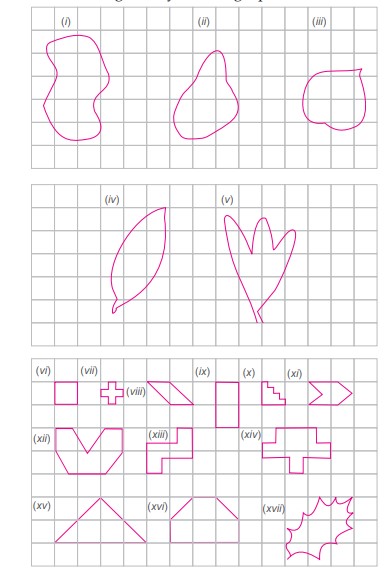
18. Find the area in square metre of a piece of cloth 1m 25 cm wide and 2m long.
19. The area of a rectangular garden 50 m long is 300 sq.m. Find the width of the garden.
20. Five square flower beds each of sides 1m are dug on a piece of land 5 m long and 4 m wide. What is the area of the remaining part of the land?
21. The cost of cementing the floor of a square room at the rate of Rs.22 per sq.m is Rs.550. Find the length of the room.
22. How many square tiles with dimension 5 cm can be fitted in a small surface whose length is 48 cm and breadth is 25 cm?
23. The total cost of flooring a room at Rs.8.50 per sq. metre is Rs.510. If the length of the room is 8 metres, find its breadth.
24. One metre is equal to 100 cm. How many sq cm are there are in one sq.m?
25. How many tiles with dimensions 14 cm and 9 cm will be needed to fit a region whose length and breadth are 168 cm and 72 cm?
Q-6
Find the perimeter of each of the following figures :
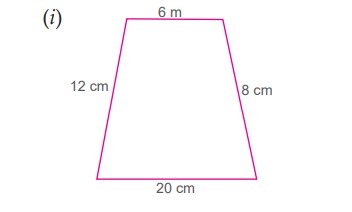
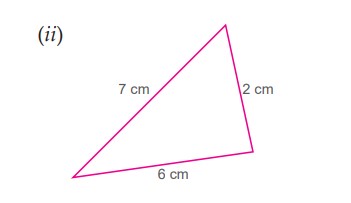

Q-7
Find the perimeter of a rectangle whose
(i) length = 34 m and breadth = 26 m
(ii) length = 15.4 cm and breadth = 6.5 cm
(iii) length = 8.6 m and breadth = 2.45m
Q-8
Find the perimeter of a square whose side is
(i) 7 m
(ii) 13 cm
(iii) 1/56 cm
Q-9
Find the area of the rectangle with:
(i) Length = 40 cm, Breadth = 20 cm
(ii) Length = 20 m, Breadth = 30 m
(iii) Length = 14.5 cm, Breadth = 8.0 cm
(iv) Length = 4.5 m, Breadth = 75 m
Q-10
Find the area of the square with side:
(i) 43 cm
(ii) 5.6 cm
(iii) 63 mm
(iv) 2.6 cm
Multiple Choice Questions
Q-1 _________ is the branch of mathematics which deals with measurement of lengths and area of plane figures/ objects and volume of solids.
(i)
Mensuration(ii)
Area(iii)
none of theseQ-2 The ________ of a closed figure is the length of the boundary of the figure.
(i)
perimeter(ii)
area(iii)
none of theseQ-3 The perimeter is the total distance around the outside of a _______ shape or a plane figure.
(i)
plane(ii)
2D(iii)
3DQ-4 The ________ of the lengths of all the sides of a closed figure is called its perimeter
(i)
sum(ii)
difference(iii)
productChapter-12 Symmetry
Q-1 Fill in the blanks:
Q-2 True or False:
Q-3 One word answer:
Q-4
Draw the line of symmetry of each of the following figures :
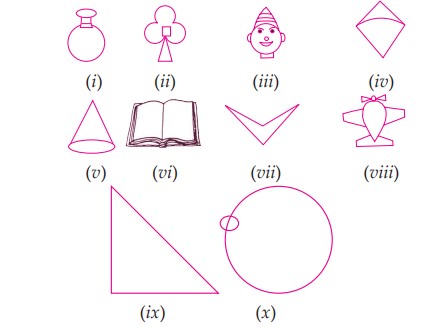
Q-5
For each of the following letters, draw all line of symmetry, if possible :
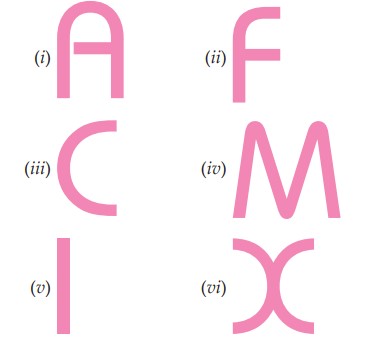
Q-6
Draw the other half of each of the figures to make it symmetrical:
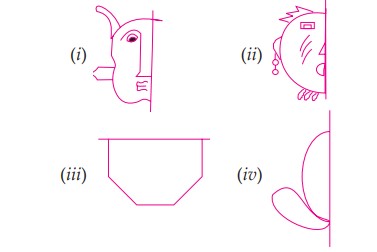
Q-7
Copy the following on a squared paper and complete them so that the dotted line is the axis of symmetry.
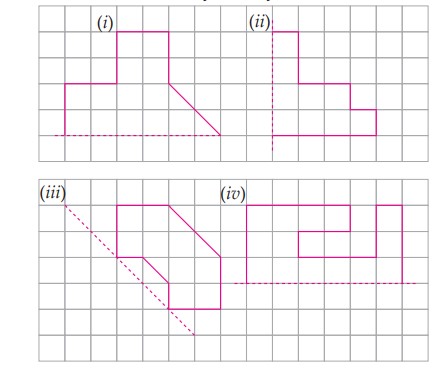
Q-8
Can you draw a triangle which has
(a) Exactly one line of symmetry?
(b) Exactly two lines of symmetry?
(c) Exactly three lines of symmetry?
(d) No lines of symmetry?
Q-9
Numericals:
1. Identify any three letters of the English alphabet through which no line of symmetry can be drawn.
2. Mark two points x and y 6.5 cm apart. Draw a line AB so that the two points marked as x and y are symmetric with respect to the line AB. Give a special name to line AB.
3. Write all letters of English alphabet which have more than two lines of symmetry.
Q-10
Complete the figures given below, so that the resulting figures has two lines of symmetry.
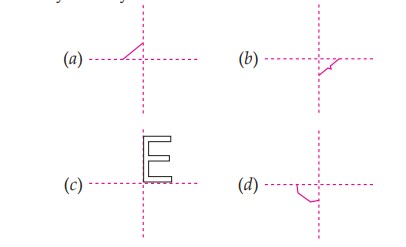
Q-11
How many lines of symmetry can be drawn through:
(i) an oval
(ii) the English letter C
(iii) an isosceles trapezium
(iv) a regular pentagon
(v) a square
(vi) a circle
Q-12
Draw the line (or lines) of symmetry of the following shapes and count their number.
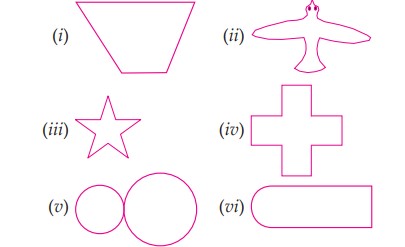
Q-13
Complete the following table:
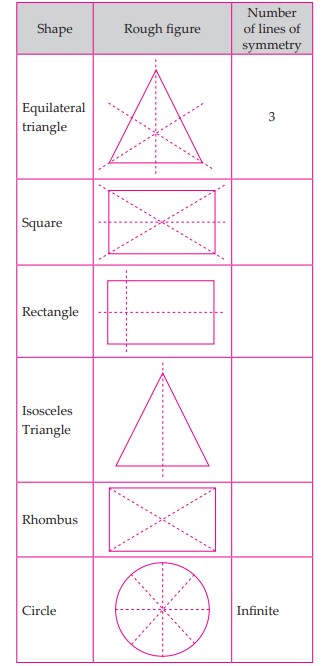
Q-14
Copy the following drawing on a squared paper and complete them so that the two dotted lines are the two lines of symmetry.

Q-15
Study the letters given below: HANDSOME
(i) Which letter has infinite lines of symmetry?
(ii) Which two letters have more than one line of symmetry?
(iii) Which letter has no line of symmetry?
Q-16
In each figure alongside, a letter of the alphabet is shown along with a vertical line. Take the mirror image of the letter in the given line. Find which letters look the same after reflection (i.e. which letters look the same in the image) and which do not. Can you guess why?

Multiple Choice Questions
Q-1 __________ is defined as harmonious proportions of a structure that allows an object to be divided into parts of an equal shape and size.
(i)
Mensuration(ii)
Symmetry(iii)
none of theseQ-2 _______ is a regular balanced arrangement on both sides of a line.
(i)
Mensuration(ii)
Symmetry(iii)
none of theseQ-3 Letter _________ of English alphabet has a line symmetry.
(i)
A(ii)
F(iii)
GChapter-13 Constructions
Q-1 Fill in the blanks:
Q-2 True or False:
Q-3 One word answer:
Q-4
Numericals:
1. Draw a line segment of length 7.4 cm using a ruler.
2. Construct a line segment of length 5.4 cm using ruler and compass.
3. What is the difference between a line and a line segment.
4. Draw any line segment PQ. Without measuring PQ, construct a copy of PQ.
5. Construct a line segment of length 10 cm. From this cut a segment AC of length 4.6 cm. Measure the remaining segment.
6. Construct the line segment of the 4.8 cm length using a ruler.
7. Draw a line l and mark a point x on it. Through x, draw a line segment sy perpendicular to l. Now draw a perpendicular to sy at y. (use ruler and compass.
8. Draw a line LM and take a point P not lying on it. Using set squares, construct a perpendicular from P to the line LM.
9. Draw any line segment AB. Mark any point M on it. Through M, draw a perpendicular to AB. (use ruler and compass).
10. Draw a line segment AB = 8 cm. Mark a point P on AB such that AP = 4.5 cm. Draw a ray perpendicular to AB to P by (i) using set squares. (ii) using compass.

12. Draw AB of length 7.3 cm and find the axis of symmetry?
13. Draw a circle of radius 4 cm. Draw any two of its chords. Construct the perpendicular bisector of these chords. Where do they meet?
14. Draw a line segment of length 12.8 cm. Using compass, divide it into four equal parts. Verify by actual measurement.
15. Draw a line segment of length 9.5 cm and construct its perpendicular bisector.
16. Draw a circle with centre C and radius 4.3 cm. Draw any chord AB. Now, construct the perpendicular bisector of AB and examine of if passes through the centre.
17. Draw a circle of radius 3.5 cm.
18. In the figure name the radii and diameters of the circle.
19. Draw a circle with centre O and radius 3.7 cm.
20. Draw an angle of measure 135° and bisect it.
21. Draw an angle and label it as ∠BAC construct ∠EDF such that ∠EDF = 2∠BAC.
22. Draw an angle of measure 45° and bisect it.
23. Draw POQ of measure 75° and find its line of symmetry.
24. Draw an angle of 40°. Copy its supplementary angle.
Q-5
Use the figure to name:
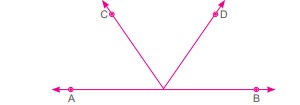
(a) 4 points
(b) a line.
Q-6
Using the line segments given in the figure.

(i) Draw a line segment equal to (2x – 2y)
(ii) Draw a line segment equal to (x + y)
(iii) Draw a line segment equal to (3x – 3z)
Q-7
Construct the line segment of the following length using compass:
(i) 5.6 cm
(ii) 4.5 cm
Q-8
Draw the perpendicular bisector of a line segment XY whose length is 11.2 cm.
(a) Take any point P on the right bisector drawn. Examine whether PX = PY.
(b) If M is the midpoint of XY, what relation is there between the length MX and XY?
Q-9
Draw any circle and mark points A,B and C such that
(i) A is on the circle
(ii) B is in the interior of the circle.
(iii) C is in the exterior of the circle.
Q-10
Fill in the blanks.
(i) A diameter of a circle is a chord that ____________ the centre.
(ii) Radius is ____________ of the diameter.
(iii) The distance between any two points on a circle is called ____________.
(iv) Any part of a circle is called an ____________ of the circle.
(v) All the points on the circle as well as in the interior of the circle from the ____________.
Q-11
How many degrees are there in:
(i) two right angle
(ii) one-sixth of a right angle
(iii) one-ninth of a right angle
(iv) five-sixth of a right angle
Q-12
Construct with ruler and compass, angles of following measures:
(i) 60°
(ii) 90°
(iii) 120°
(iv) 135°
Multiple Choice Questions
Q-1 Geometric __________ are made with the aid of a ruler and compasses only.
(i)
rulers(ii)
constructions(iii)
none of theseQ-2 ________ are made with the aid of additional instruments, such as protractor and ruler.
(i)
Drawings(ii)
Constructions(iii)
none of theseQ-3 A metre is divided into _________ equal parts and each part is a centimetre.
(i)
10(ii)
100(iii)
none of theseChapter-14 Data Handling
Q-1

(i) Which class has read the most number of books?
(ii) Which class has read the least number of books?
(iii) How many more books were read by class V than class VI?
(iv) How many more books were read by class VII than Class VIII?
Q-2
Ekta is asked to collect data for size of shoes of students in her class. Her findings are recorded in the manner shown below:
Javed wanted to know

(i) The size of shoes worn by the maximum number of students.
(ii) The size of shoes worn by the minimum number of students. Can you find this information?
Q-3
The daily wages of 30 workers (in R) in a factory is given below. Make a table for the data using tally marks.
Answer the following questions:

(i) What is the maximum daily wages of a worker?
(ii) What is the minimum daily wages of a worker?
(iii) How many workers are earning less than `50 per day?
Q-4
Define the terms:
(i) Data
(ii) Raw data
(iii) Array
Q-5
A dice was thrown 30 times and the following outcomes were noted:

Represent the above data in the form of frequency distribution.
Q-6
Following is the data collected form 50 students of their favorite fruits, a stands for mangoes, b for apples, c for oranges, d for bananas, e for grapes.
The raw data is as follows:

Prepare a frequency chart.
Q-7
A dice is thrown 35 times and following outcomes are recorded:

Represent the above data in the form of frequency distribution.
Q-8
The number of fans produced by a factory in the four weeks of October are given below:
Observe the pictograph and answer the following questions:

(i) In which week were the maximum number of fans produced? How many?
(ii) In which week were the least number of fans produced? How many?
(iii) How many fans were produced in the first week?
(iv) What is the total number of fans produced in October?
Q-9
The pictograph shows how much pocket money six pupils get each week.
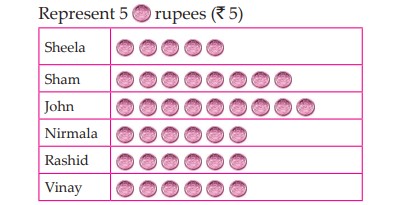
(i) Without counting, tell who gets the least pocket money each week.
(ii) How much money did they get altogether? (tell by counting)
(iii) Who gets exactly Rs 45?
(iv) How much money did Nirmala get?
Q-10
The colours of fridges preferred by people living in a locality are shown by the following pictograph:
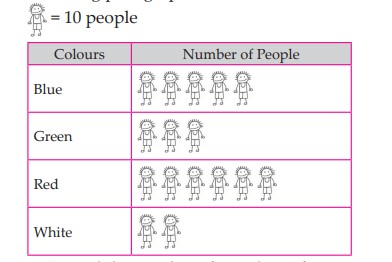
(i) Find the number of people preferring blue colour.
(ii) How many people liked red colour?
Q-11
The table below shows the number of students playing four different games.

Present this information as a pictograph. You can use stickers to make the pictographs.
Q-12
The following are the details of number of students present in a class of 30 during a week. Represent it by a pictograph.
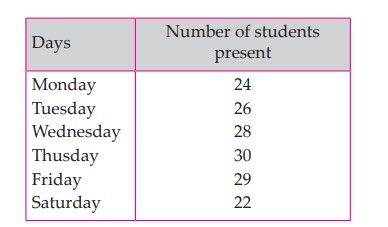
Q-13
In a monthly test, the number of students passed in various subjects are give below:
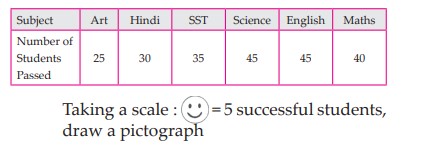
Q-14
The number of stools in five rooms of a school are given below:
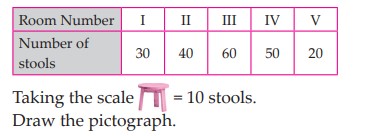
Q-15
Total number of animals in five villages are as follows:
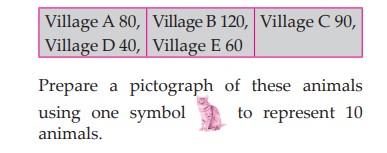
Q-16
The horticulture department made a table to show the number of trees of different types planted inside the gardens and public buildings of a city.
Prepare a pictograph to represent the above data.

Q-17
The table below shows the number of cars sold in different cities in the month of August.
Represent the above data by a pictograph.
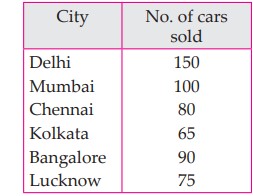
Q-18
The following graph represents the number of people of different countries in a world summit:
Answer the following questions:
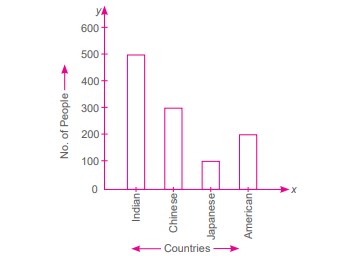
(i) How many Indians were present?
(ii) Which country has minimum representatives?
(iii) Which country has maximum representatives?
(iv) Which countries have the same number of representatives?
(v) What is the total number of people in the summit?
Q-19
The bar graph given below shows the amount of wheat purchased by government during the year 1998-2002.
Read the bar graph and write down your observations. In which year was

(i) The wheat production maximum?
(ii) The wheat production minimum?
Q-20
Read the graph and answer the following questions:

(i) Which is the coldest month?
(ii) How much more snowfall is there in January than in December?
(iii) How many centimeters of snowfall was there in the month of March?
(iv) Which month onwards do you see the snowfall increasing?
Q-21
In a survey of 150 families, the number of children in each family was recorded and the data has been represented by the bar graph, given below:
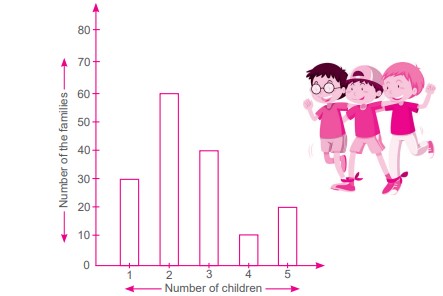
(i) What information does the bar graph give?
(ii) How many families have 2 children, 3 children and 5 children?
(iii) How many families have no child?
(iv) What percentage of families have 4 children?
Q-22
The bar graph shows the speed in km per hour of different vehicles (means of transport). Read the bar graph and answer the questions given below.

(i) Which vehicle has maximum speed among all?
(ii) Which means of transport has minimum speed?
(iii) What is the speed of bus?
(iv) Is 10 km/hr the speed of scooter or the truck?
Q-23
51 students from a locality use different modes of transport to a school as shown by the bar graph given below: Look at the bar graph and answer the questions given below:

(i) What does the bar graph show?
(ii) Which mode of transport is used by maximum number of students?
How many students use bus for going to school?
(iv) How many students of the locality do not use bus for going to school?
Q-24
Observe this bar graph which shows the marks obtained by Aziz in half-yearly examination in different subjects.
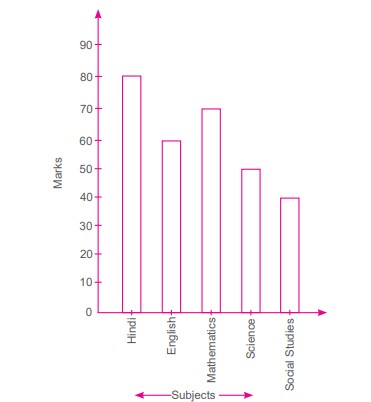
(a) What information does the bar graph give?
(b) Name the subject in which Aziz scored maximum marks.
(c) Name the subject in which he has scored minimum marks.
Q-25
Numericals:
1. Draw a bar graph to represent the data given below:

2. Draw a bar graph to show the following:

3. Draw a bar graph to show the following data:

4. Make a bar graph for the following data. The table shows the number of books read by the class in the past month.

5. The approximate population of India as found by census surveys in different decades is as follows:

6. The strength of classes I to VIII on 1.4.2013 in Modern Public School are given below:

7. A survey of 120 school students was done to find which activity they prefer to do in their free time. Preferred activity: playing, reading story books, watching TV, listen to music and painting.

8. India’s foreign trade export was as given below:
Draw a bar graph to represent the data.

9. The following table show computers sets which are sold out during the week
